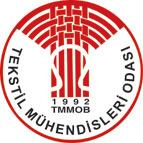|
|
Tekstilde Çapraz Bağlı Enzim Topluluklarının Kontrollü Yüzey Modifikasyonunda Kullanılması
| « Sayıya Dön |
| Yıl | : | 2015 (Cilt:22) |
| Sayı | : | 97 |
| Yazarlar | : | Alixander PERZON, Cedric DICKO, Özgür ÇOBANOĞLU, Onur YÜKSELEN, Estera DEY, Jitka ERYILMAZ |
| DOI | : | 10.7216/130075992015229707 |
| Makale Özeti | : | PDF İndir |
| Makale | : | PDF İndir |
| Kaynaklar | : |
| 1.
Mojsov, K. (2011), Application of enzymes in the textile industry: a
review. in II International Congress "Engineering, Ecology and Materials
in the Processing Industry". Jahorina, Bosnia and Hercegovina: UGD
Academic Repository. |
| |
2. Cavaco-Paulo, A., Gubitz G., eds. (2003), Textile processing with enzymes. Woodhead Publishing Ltd: Cambridge England.
http://dx.doi.org/10.1201/9780203500941 |
| |
| 3. Schmitt B., Prasad A.K., (1998), Update of indigo denim washing. Colourage, 45(10): p. 20-24. |
| |
4. Bhat M.K., (2000),Cellulases and related enzymes in biotechnology. Biotechnology Advances, 18(5): p. 355-383.
http://dx.doi.org/10.1016/S0734-9750(00)00041-0 |
| |
5. Cavaco-Paulo A., (1998), Mechanism of cellulse action in textile processes. Carbohydrate Polymers, 37: p. 273-277.
http://dx.doi.org/10.1016/S0144-8617(98)00070-8 |
| |
6.
Lenting H.B.M., Warmoeskerken M.M.C.G., (2001), Guidelines to come to
minimized tensile strength loss upon cellulase application. Journal of
Biotechnology, 89(2): p. 227-232.
http://dx.doi.org/10.1016/S0168-1656(01)00301-7 |
| |
| 7.
Klahorst S., Kumar A., Mullins M.M., (1994), Optimizing the use of
cellulase enzymes. Textile Chemist and Colorist, 26(2): p. 13-18. |
| |
8.
Cavaco-Paulo A., Morgado J., Almeida L., and Kilburn D., (2000), Indigo
backstaining during cellulase washing. Textile Research Journal, 68(6):
p. 398-401.
http://dx.doi.org/10.1177/004051759806800602 |
| |
| 9.
Gusakov A.V., Sinitsyn P., Markov A. V., Skomarovsky A. A., Sinitsyna
O. A., Berlin A. G., and Ankudimova N. V., (2000), Indigo-binding
domains in cellulase molecules. Biocatalysis- 2000: Fundamentals and
Applications, (095): p. 77-80. |
| |
10.
Pazarlioğlu N.K., Sariişik M., Telefoncu A., (2005), Treating denim
fabrics with immobilized commercial cellulases. Process Biochemistry,
40(2): p. 767-771.
http://dx.doi.org/10.1016/j.procbio.2004.02.003 |
| |
| 11.
Popdrepsek G.H., Primožiþ M., Knez Ž., Habulin M., (2012),
Immobilization of cellulase for industrial production, in Chemical
Engineering Transactions. p. 235-240. |
| |
12.
Yu Y., Yuan J., Wang Q., Fan X., Wang P., Cui L., (2001), A promising
approach for bio-finishing of cotton using immobilized acid-cellulase.
Fibers and Polymers, 15(5): p.932-937.
http://dx.doi.org/10.1007/s12221-014-0932-2 |
| |
13. Cao L., (2005),Immobilised enzymes: science or art? Current opinion in chemical biology, 9(2): p. 217-26.
http://dx.doi.org/10.1016/j.cbpa.2005.02.014 |
| |
14.
Hanefeld U., Gardossi L., and Magner E., (2009), Understanding enzyme
immobilisation. Chemical Society Reviews, 38(2): p. 453-68.
http://dx.doi.org/10.1039/B711564B |
| |
15.
Dalal S., Sharma A., Gupta M.N., (2007), A multipurpose immobilized
biocatalyst with pectinase, xylanase and cellulase activities. Chemistry
Central Journal, 1(1): p. 16-16.
http://dx.doi.org/10.1186/1752-153X-1-16 |
| |
16.
Broun G.H., (1976), Chemically aggregated enzymes, in Method in
Enzymology, K. Mosbach, Editor. Academic Press: New York. p. 263-580.
http://dx.doi.org/10.1016/S0076-6879(76)44022-3 |
| |
17.
Reza R.T., Pérez C.A.M., González C. A. R., Romero H. M., Casillas P.
E. G.., (2010), Effect of the polymeric coating over Fe3O4 particles
used for magnetic separation. Central European Journal of Chemistry,
8(5): p. 1041-1046.
http://dx.doi.org/10.2478/s11532-010-0073-4 |
| |
18.
Talekar S., Ghodake V., Ghotage T., Rathod P., Deshmukh P., Nadar S.,
Mulla M., Ladole M., (2012), Novel magnetic cross-linked enzyme
aggregates (magnetic CLEAs) of alpha amylase. Bioresource Technology,
123: p. 542-547.
http://dx.doi.org/10.1016/j.biortech.2012.07.044 |
| |
19.
Sandip B., Bule M.V., Singhal R.S., Ananthanarayan L., (2009), Glucose
oxidase — An overview. Biotechnology Advances, 27: p. 489-501.
http://dx.doi.org/10.1016/j.biotechadv.2009.04.003 |
| |
20.
Gusakov A., Sinitsyn A.P., Berlin A.G., Markov A.V., Ankudimova N.V.,
(2000), Surface hydrophobic amino acid residues in cellulase molecules
as a structural factor responsible for their high denim-washing
performance.Enzyme and microbial technology, 27(9): p. 664-671.
http://dx.doi.org/10.1016/S0141-0229(00)00264-7 |
| |
| 21.
Gusakov A.V., Sinitsyn A.P., (2000), Indigo-binding domains in
cellulase molecules. Biocatalysis-2000: Fundamentals and Applications,
41(6): p. 77-80. |
| |
22.
Markov A.V., Gusakov V., Kondratyeva E. G., Okunev O. N., Bekkarevich
A. O., Sinitsyn A. P., (2005), New effective method for analysis of the
component composition of enzyme complexes from Trichoderma reesei.
Biochemistry. Biokhimi͡ia, 70(6): p. 657-63.
http://dx.doi.org/10.1007/s10541-005-0166-4 |
| |
23.
Sinitsyn A.P., Gusakov, A.V., Grishutin, S.G., Sinitsyna, O.A.,
Ankudimova, N.V, (2001),Application of microassays for investigation of
cellulase abrasive activity and backstaining. Journal of Biotechnology,
89(2-3): p. 233-8.
http://dx.doi.org/10.1016/S0168-1656(01)00306-6 |
|
|


